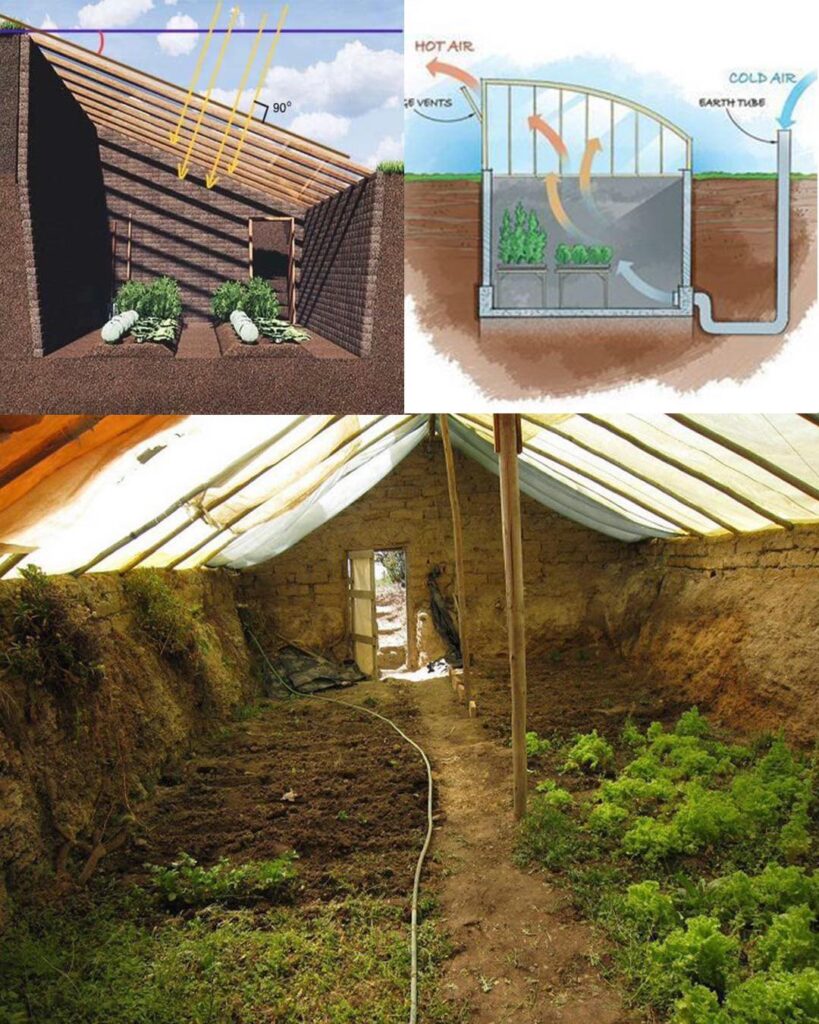Growing plants year-round, especially in unpredictable or colder climates, can be a challenge. Enter the underground greenhouse, also known as a walipini or pit greenhouse. This innovative design uses the Earth’s natural insulating properties to create a stable environment for plants, extending the growing season and offering a sustainable solution for gardeners and farmers alike.

1. Benefits of an Underground Greenhouse
- Thermal Stability: The soil below ground level maintains a relatively constant temperature year-round, helping keep your greenhouse warm in winter and cool in summer.
- Weather Protection: Shielded from the elements, underground greenhouses are less vulnerable to wind, hail, or snow damage.
- Extended Growing Seasons: The consistent temperature allows plants to thrive even during the harshest months.
- Energy Efficiency: The natural insulation reduces or eliminates the need for supplemental heating, making it a sustainable option.
- Cost Savings: Over time, the reduced need for heating and weather repairs can save significant resources.
2. Selecting the Best Location
- Maximize Sunlight: Choose a spot with ample sunlight exposure. For those in the Northern Hemisphere, aim for a south-facing location; for the Southern Hemisphere, north-facing is ideal.
- Ensure Proper Drainage: Avoid low-lying areas prone to water accumulation. Consider adding gravel paths or raised beds to aid drainage.
- Accessibility: Select a location that’s easy to reach throughout the year, even in adverse weather conditions.
3. How to Build an Underground Greenhouse

a. Excavation
- Depth: Dig 8–10 feet deep to leverage the Earth’s insulation. The exact depth depends on your local frost line and climate.
- Dimensions: Adjust the width and length based on your needs. A 10×20-foot greenhouse is a good starting point but can be scaled up or down.
b. Constructing Walls
- Material Choices: Use bricks, stones, or earthbags for durability. Reinforce with concrete if required for structural stability.
- Insulation: The northern wall should be well-insulated to retain heat. Materials like straw bales, foam insulation, or double-layered earth can be used effectively.
c. Roofing
- Light and Protection: Use UV-resistant greenhouse plastic, polycarbonate panels, or tempered glass for the roof.
- Design: Create a sloped roof to maximize sunlight and facilitate rain and snow runoff.
d. Flooring
- Drainage Focus: A gravel floor promotes drainage, though concrete or natural soil can also be used based on personal preference.
e. Ventilation
- Air Circulation: Install vents or windows at the higher points of the roof to allow hot air to escape.
- Accessibility: Place doors at either end for easy access and to promote cross-ventilation.

4. Maintenance for Year-Round Success
- Temperature and Humidity: Regularly monitor these factors with a thermostat or humidity gauge to ensure optimal growing conditions.
- Pest Management: Check frequently for pests that may take advantage of the enclosed space. Use organic or natural deterrents to protect your plants.
- Watering Practices: Adjust your watering schedule based on plant needs and the greenhouse’s humidity levels to avoid waterlogging.
5. Pro Tips for Optimal Use
- Thermal Mass Storage: Place water barrels or large stones inside the greenhouse to absorb heat during the day and release it at night, stabilizing temperatures.
- Raised Beds: Elevating the planting beds helps prevent root rot and improves soil drainage.
- Reflective Walls: Install reflective surfaces like aluminum sheets or white-painted walls to maximize light distribution within the space.
Conclusion
Building an underground greenhouse offers an incredible opportunity to grow fresh produce year-round while conserving energy and protecting plants from extreme weather. Though it requires careful planning and initial effort, the long-term benefits of abundant harvests, reduced heating costs, and sustainable gardening practices are worth the investment.
Are you ready to take your gardening to the next level? Embrace the innovation of an underground greenhouse and enjoy fresh, homegrown produce no matter the season.
Inspired by this? Share the guide with your fellow gardening enthusiasts!





